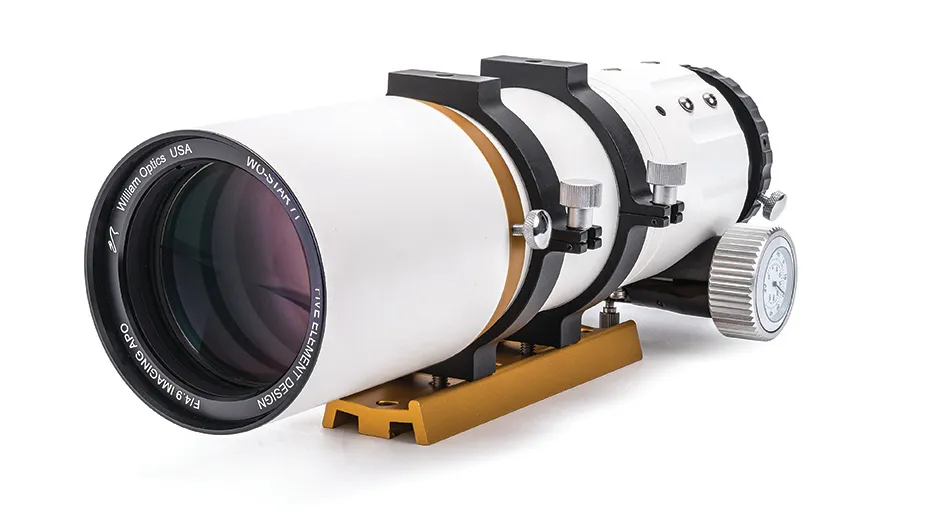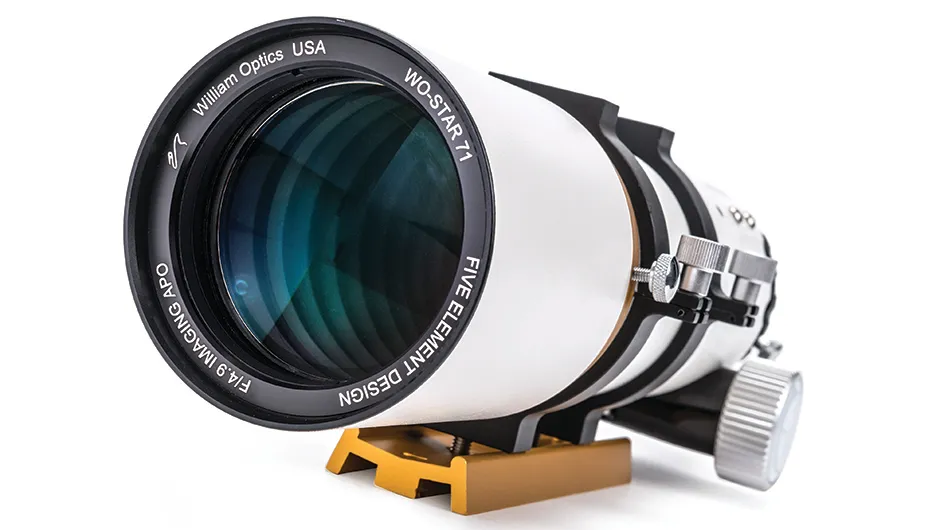William Optics' Star 71 five-element apo comes in a package that comprises an optical tube, tube rings with a Vixen dovetail bar, 2.5-inch dual-speed rack and pinion focuser with built-in thermometer, front and rear metal covers and an M48-Canon EOS adaptor ring.
If you have a non-Canon DSLR, you’ll need to buy a suitable adaptor.
Cheap refractors suffer from chromatic aberration: a defect where not all colours are brought to the same focus, as well as field curvature.
Combined, these lead to distorted star shapes at the edge of the image field of view.
Visually a doublet design can improve chromatic aberration, but triplet lenses are often used in scopes intended for imaging as they provide a higher degree of colour correction.
Overall triplets work well, but still leave fast apo refractors with some field distortion around the edges.

Flat out success
One way to fix this problem is to buy an external flat-field corrector.
William Optics has gone even better here, opting for a five-element arrangement: a triplet as the front objective and two correcting lenses, one of which is flat field.
As the Star 71 is expressly intended for imaging, the back of the focusing unit ends in a male M48 thread – which means you can’t add a regular star diagonal for visual observing.
William Optics has stated that it will be stocking a custom 1.25-inch 90° dielectric mirror diagonal to allow visual use, but this was not available in the UK at the time of review.
However we did discover we had a suitable adaptor that allowed us to attach an eyepiece for straight-through viewing with our own 26mm and 17mm eyepieces.
The Vixen mounting bar has a tripod thread, allowing us to attach the scope to a standard tripod.
We enjoyed crisp wide field views with our 26mm eyepiece and slightly more magnified views with the 17mm.
Stars were sharp to the edges as we’d expect from something designed specifically for a flat field; there’s every indication that with the custom diagonal the Star 71 can be turned into a visual instrument if you so wish.
But this is primarily an imaging instrument so we attached our Canon EOS 50D DSLR to the scope and set them on an NEQ6 Go-To mount, giving us the ability to capture exposures of up to four minutes without guiding.
The camera’s APS-C sensor, coupled with the Star 71, equates to an image scale of 3.65° by 2.4°, a nice wide field of view.
Full format camera sensors will give an even wider view of 5.9° by 3.9°, which is large enough to photograph sprawling targets such as the Veil Nebula and Andromeda Galaxy comfortably.
We imaged the Pleiades star cluster, taking a series of exposures of 30 seconds each to ensure no trailing.
Stars at the corners were still crisp and well rounded with no sign of distortion.
The final stacked image, made from two sets of data on different days, showed an enjoyable amount of nebulosity too.
We also experimented with taking hydrogen-alpha images of the Veil Nebula Complex, partly because of moonlight and partly due to the scale of the object.
We achieved 12 exposures of four minutes each at ISO 3200, showing the whole complex bar a fainter section of the western section.
Overall, William Optics has produced a good looking, compact imaging telescope that gives sharp stars out to the field edges and good colour correction.
We can recommend it to anyone interested in wide-field imaging.

Slight and light
The combination of compactness and lightness, even with the tube rings and Vixen dovetail bar attached, make this a viable travel telescope as well as one that can capture great wide-field vistas.
The telescope tube weighs just 2.05kg; even with the ring and dovetail bar attached it’s only 2.4kg, and at 324mm long it can fit in airline hand luggage.
Its size and weight makes it suitable for any of the travel mounts reviewed in these pages, enabling you to take it abroad to capture large deep-sky objects that are not visible from your regular observing sites.
Add to that the excellent colour, field correction and fast focal length, and you’ll find that lots of short image exposures of a minute or so will give great results.
Tube rings and Vixen bar
The scope is supplied with a sturdy and nicely crafted pair of tube rings, which are lightweight and easy to use.
There are threaded holes on the top of each one so that you can add other accessories, such as a guidescope.
The rings attach via a Vixen-style mounting bar.
Focuser
The dual-speed rack and pinion focuser built into the rear of the telescope was a delight to use.
The screw at the base enables you to lock the focus position and didn’t move even with our DSLR attached, though there was a tiny image shift when initially locking it.
Dew shield
The retractable dew shield was smooth to use, being easy to retract for storage and capable of being locked in place with a thumbscrew.
Though the shield seemed a little short, it gave good protection from dewing up under normal conditions.
Optics
The patented five-element design incorporates a multicoated triplet objective lens at the front and two further lenses farther down the tube to provide additional colour and field correction.
The lenses made of FPL-53 low-dispersion glass for colour-free apochromatic performance.
Internal baffles
There are internal baffles at both ends and these are coated with matt paint to cut down on stray light bouncing around inside the tube.
They do a good job in preventing internal reflections, which would otherwise spoil the contrast of faint deep-sky objects.
Vital stats
- Price £999.00
- Aperture 71mm (3 inches)
- Focal Length 350mm (f/4.9)
- Weight 2.4kg with tube rings and Vixen bar
- Supplier The Widescreen Centre
- Telephone 020 7935 2580
- www.widescreen-centre.co.uk
This review originally appeared in the January 2015 issue of BBC Sky at Night Magazine.
